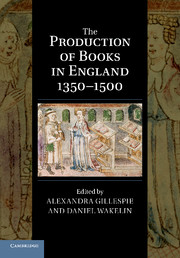Book contents
- Frontmatter
- Contents
- List of illustrations
- List of contributors
- Foreword
- Acknowledgements
- List of abbreviations
- Introduction
- 1 Materials
- 2 Writing the words
- 3 Mapping the words
- 4 Designing the page
- 5 Decorating and illustrating the page
- 6 Compiling the book
- 7 Bookbinding
- 8 Commercial organization and economic innovation
- 9 Vernacular literary manuscripts and their scribes
- 10 Book production outside commercial contexts
- 11 Censorship
- 12 Books beyond England
- 13 English books and the continent
- Afterword: the book in culture
- Bibliography
- Index of manuscripts
- General index
6 - Compiling the book
Published online by Cambridge University Press: 05 May 2014
- Frontmatter
- Contents
- List of illustrations
- List of contributors
- Foreword
- Acknowledgements
- List of abbreviations
- Introduction
- 1 Materials
- 2 Writing the words
- 3 Mapping the words
- 4 Designing the page
- 5 Decorating and illustrating the page
- 6 Compiling the book
- 7 Bookbinding
- 8 Commercial organization and economic innovation
- 9 Vernacular literary manuscripts and their scribes
- 10 Book production outside commercial contexts
- 11 Censorship
- 12 Books beyond England
- 13 English books and the continent
- Afterword: the book in culture
- Bibliography
- Index of manuscripts
- General index
Summary
Book production in a manuscript culture was a more laborious task than in the present day, involving more stages and more labour. It might be compared with medieval food preparation where the chef was often required to be both butcher and cook, as a contemporary recipe for ‘signet roste’ demonstrates:
Tak a swane and kute the rofe of his mowthe ynto the braynward endelongys withe a knyf and let hym blood to dethe or elys brek his neke and kute his nek ynto a knot and let hym blode and kepe the blode yn a faire vessele for the sawce and skald hym and draw hym and rost hym as a gose.
A similar quest for raw ingredients was very much part of the task of producing a manuscript, and even supposing a convenient supply of physical materials (parchment, paper and ink, as discussed by Orietta da Rold in Chapter 1, above), there remained the problem of acquiring suitable textual material to fill the book. Scribes needed exemplars from which to work, and compilers, supervisors and traders needed booklets or other segments of ready-to-read text. Ralph Hanna has emphasized the important part played in fourteenth- and fifteenth-century English book production by ‘exemplar poverty’, with manuscript compilers never sure when, or even if, copy-texts for any given work might become available. In response, he argues, compilers were constrained to make the fullest possible use of whatever exemplars they had, with consequences for the organization of particular volumes (as will be discussed below).
- Type
- Chapter
- Information
- The Production of Books in England 1350–1500 , pp. 129 - 149Publisher: Cambridge University PressPrint publication year: 2011
- 4
- Cited by



